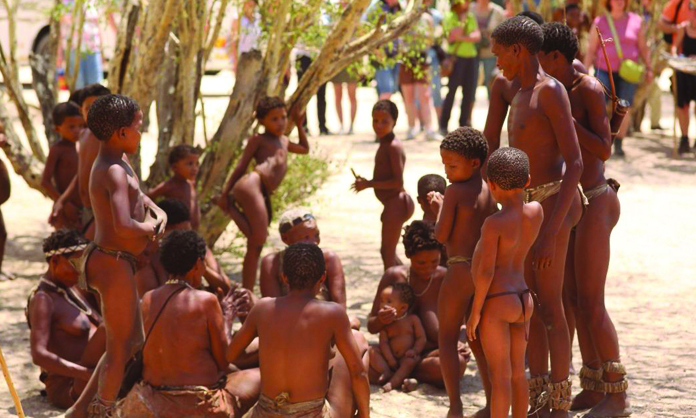The San and Damara living museums display the forgotten history of these indigenous communities in Namibia, while international organisations have called the government to treat marginalised communities as equals.
These communities continue to be marginalised but hope the concessions from these museums will uplift and preserve their cultural heritage. From their dances, to jewellery making, hunting and living in the bush, the Damara and San communities provide a window into their ways for the rest of the world.
Siony //Gaseb, speaking at the Damara Living Museum on Thursday afternoon, said they want to ensure their culture does not die and that future generations know where they come from.
“This museum is to keep our culture alive and to show our younger children about our culture, how our ancestors were living way back in the past. As well as to keep the culture alive because we have lost our culture at a very early time, that’s why we built this museum,”
//Gaseb said.
He said Damara goabs (kings) used to have more than two wives and would play a game called //hu¯s to settle any disputes.
The museum mimics old-time villages, designed in a circular format with an open middle section for dancing activities, and sections for blacksmiths, traditional medicines, a women’s workshop for jewellery making, a corner for traditional beer and a cooking area.
The community’s traditional blacksmiths made knives and multifunctional tools. “The multifunctional tool [can be] used for shaving, removing hair from the animal skin and we can use it as an axe,” he said.
//Gaseb said traditional beer was made from grass seeds and becomes stronger the longer it ferments.
“These seeds are especially collected by the ants. The ants collect the seeds for their food, then they store it under the ground. While they store it under the ground, when the rain comes the seeds get wet. When the seeds are wet and the rain is gone, the ants take it out to dry. Once it is dry, we collect the seeds from the ants, we steal them. We clean it and mix it with water and honey. It must stand for more than five days,” he explained.
The museum is run by the Living Culture Foundation Namibia, a non-profit German-Namibian organisation. The museum’s aim is to help communities establish ways that allow them to profit from their traditional skills by generating an income. Both the San and Damara communities face hardships in modern day Namibia.
Xao Kgau, the head of the community at the Omandumba San Living Museum at !Oe≠gans in the Dâures constituency, told the media on Tuesday families are rotated there every three months.
They live at Tsumkwe in north-eastern Namibia, which has one of the biggest San communities in the country. “We come here to stay for three months and show the traditional lives, how the elders lived in former times. When we are done, we go back, then the other families come,” Kgau said. Traditional authorities have concessional land where they can earn a profit, which goes into a trust for their benefit.
Amnesty International and an African Peer Review Mechanism (APRM) report this month flagged the mishandling of indigenous communities, especially the San community.
The APRM condemned the government for dispossessing marginalised communities of their land which supports their way of living. It found that Namibia’s indigenous people are still being deprived of their land rights through encroachment by more powerful neighbours and elites. “It is advisable for the government to urgently address the matter so that indigenous people should feel that they are fully part of the Namibian nation with the same rights as the rest of the population,” noted the report.
Highlighting the struggles of the San community, the report states that the San are disadvantaged in the enjoyment of economic, social and cultural rights.
“They had been forcefully deprived of their land in colonial times, including what became known as the Etosha National Park, without consultation or compensation,” the report reads.
In their submission to a United Nations (UN) office, Amnesty International stated that the San community has historically been dispossessed of their ancestral land, which was a source of their livelihood, cultural identity and customary way of life, by successive administrations that have run Namibia. “Additionally, the crowded housing conditions and inadequate sanitation in which San people live, coupled with limited access to water, further exacerbate community spread. The denial of their right to an adequate standard of living calls for urgent measures to address historical injustices,” the submission reads.
Speaking on the indigenous communities, political analyst Rui Tyitende recently told The Namibian the Ovahimba, San and other minority communities will continue to suffer as policy positions and programmes are formulated and implemented without consulting the affected communities.
“Most of their problems are man-made as the approach towards addressing various challenges has always been a top-down approach,” Tyitende said.
Stay informed with The Namibian – your source for credible journalism. Get in-depth reporting and opinions for
only N$85 a month. Invest in journalism, invest in democracy –
Subscribe Now!






